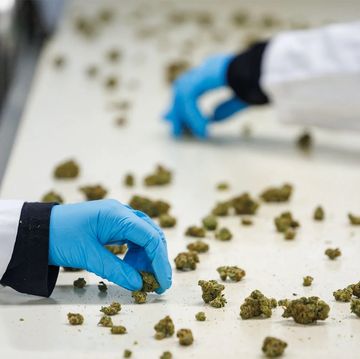Cough, fatigue, shortness of breath—is it COVID-19? The flu? In certain hotter, drier regions like California’s Central Valley (which includes Fresno and Bakersfield) and Arizona, it might be valley fever, an infection caused by the Coccidioides fungus.
The illness has gained greater attention as health authorities record a growing number of cases. More than 18,000 diagnoses were recorded in the United States in 2019, compared with about 2,800 in 2000, with fluctuation over the years, according to the Centers for Disease Control and Prevention (CDC). Valley fever is still a serious health risk: About 1 in 10 patients experiences long-term or severe effects, typically in their lungs. In relatively rare cases, the disease can be fatal, killing 200 people per year on average, according to the CDC.
This essay was adapted from the Alta newsletter, delivered every Thursday.
SIGN UP
“Your individual daily risk is very low, you know—almost zero. But, you know, with millions of people moving around, all those small numbers stack up to a significant percent,” says UC Davis associate professor of clinical medicine Dr. George Thompson, who researches valley fever and other fungal conditions.
Global warming threatens to spread valley fever to new regions, potentially taking this largely southwestern problem nationwide. By the end of the century, without an aggressive transition away from fossil fuels, states as far east and north as Nebraska and North Dakota could become hot and dry enough to host the fungus.
“Much of the western United States…could be endemic to valley fever in the future,” says Los Alamos National Laboratory Earth postdoctoral fellow Dr. Morgan Gorris, whose research demonstrates the impact of different climate scenarios on valley fever.
I had never heard of valley fever until I moved from the Bay Area to Sacramento, which sits on the fringe of the disease’s endemic area. The growing footprint of Coccidioides has concerned me, as well as air-quality problems made worse by climate change. Sacramento regularly ranks among the nation’s most-air-polluted cities, alongside several other California locations. Since moving here in 2018, I’ve found myself needing an asthma inhaler for much of the year, when previously my symptoms cropped up rarely.
People get valley fever by inhaling Coccidioides spores. Many never experience symptoms. Others may develop flu-like symptoms like fatigue, trouble breathing, aches, a rash, and—as the name implies—a fever. Up to 10 percent of people experience serious or long-term problems, usually in their lungs, according to the CDC. The disease is usually treated with antifungal medication.
Those with outdoor professions like agriculture, firefighting, archaeology, or construction are more likely to be exposed to Coccidioides. According to the CDC, Black and Filipino people are at higher risk for severe cases of valley fever, as are individuals with certain underlying conditions such as HIV and diabetes.
The Coccidioides fungus grows in the dirt when it’s moist, then becomes airborne with dust when conditions dry out. Its presence is “patchy,” says Thompson—one section of dirt might contain it, while another just five feet away doesn’t. So just because you’re in an endemic region doesn’t mean the dirt surrounding you is full of Coccidioides.
The only way to avoid valley fever with certainty is to avoid regions with the Coccidioides fungus. But what if you live in an endemic area, or have to pass through one? Millions reside in California’s Central Valley. For those who don’t, Highway 99—which runs from Chico to Bakersfield—is a faster way to cross the state than taking a coastal route. (It’s the route I typically take!)
The California Department of Public Health recommends taking measures to avoid inhaling dust. These include staying inside on windy days, keeping car windows closed and setting the fan to recirculation, and avoiding activities like gardening that kick up dirt. The National Institute for Occupational Safety and Health recommends that outdoor workers wet down dry dirt, stay upwind of digging, reduce digging with their hands, and stop work during high winds. Some experts say wearing masks, especially N95s, can help reduce risk—one possible reason why valley fever numbers actually dipped in 2020.
Thompson notes, however, that the masks most people are wearing to avoid COVID-19 are not “really recommended to prevent [valley fever], but they probably offer partial protection.” Another factor that may have contributed to the decline in cases is people cutting down on travel that might have taken them through endemic areas.
If you experience flu-like symptoms after being in an area where valley fever is known to occur, ask your doctor to test you for the infection, especially if your illness is not responding to treatments for other causes. Thompson recommends getting a second test if symptoms persist.
Valley fever is one of many illnesses expected to affect more people as the planet warms. But Gorris found something promising in her research: valley fever’s spread isn’t all inevitable.
“If we reduce greenhouse gas emissions and prevent some climate warming, the expansion of valley fever could be reduced—and that would prevent more people being exposed to the disease,” she says.
Thompson says recent funding offers hope for improvements in the treatment and prevention of valley fever. California’s 2018–2019 state budget included $8 million for research and outreach around the disease, and the National Institutes of Health gave Berkeley Public Health a five-year $3.8 million research grant in 2019.
“I think that’s been really great to see. I’m hoping it continues. But, you know, this is a very morbid infection for some people. So even though we’ve got new treatments on the way—they work, [but] they’re not going to work for 100 percent of people probably,” he says.
A vaccine against valley fever may even be on the horizon, he says. One is already in development for dogs.
Until then, the best defense is awareness. People who spend time in affected regions should be aware of valley fever in case they develop symptoms, and health professionals should be aware of the growing footprint of the Coccidioides fungus.
“I think the best way for folks to think about it is to be an advocate for their own health,” Gorris says.
While Gorris was referring to self-advocacy in a medical setting, you could also take her meaning more broadly. Valley fever, air pollution, and even allergy season are all made worse by climate change. You can advocate for your own health, as well as that of your community and future generations, by advocating for abandoning fossil fuels to cap global warming.•
Correction: December 6, 2021: An earlier version of this article incorrectly stated that Valley fever could spread to Missouri.












